70 Years of History: 1954 – 2024
Francis of Assisi Home is dedicated to living up to our Vision, making us a preferred choice in aged care. Our approach to aged care makes our residents feel valued and cared for. This can be seen in our everyday actions and in the care provided by our dedicated staff. At Francis of Assisi, staff and residents are like family – from the moment you enter our doors, you will feel welcomed, loved and cared for.
Francis of Assisi Home History

The inspiration to establish a Home for the care of the aged came from the charitable heart of the Parish Priest of St Francis Xavier’s Church, Fr. Andrew Healion in the late 1940’s. During his visitations to the hospital, he noticed that there were many aged people left, with nowhere to go. He discussed this with Mr. P.T. Dunworth, President of the St Vincent de Paul Society. The senior priest in the Mackay District, Monsignor J. Rowan, submitted the idea to the Bishop of Rockhampton, the Most Reverend Andrew Tynan who set the project in motion. He appointed Fr. Healion as organizer with the assistance of a committee. The Dupuy Street land was purchased from C. Crowley and F. Vigilante and the old Vestergaard Home in Victoria Street was moved to the site on August 2nd, 1953.
During this time, Bishop Tynan met with the Archbishop Mikiel Gonzi of Malta at Farleigh to discuss the establishment of an Aged Care Home in Mackay. As a result, the Archbishop undertook to obtain a Maltese Order of Sisters to run the Home. Mother Luisa Busuttil, then Mother General of the Franciscan Sisters of Malta (title changed to the Franciscan Sisters of the Heart of Jesus in 1969) agreed to a foundation at Mackay. Mother Amelia accompanied by Sisters Alfreda, Clarenza, Vittorina, Vianney and Ubaldina arrived on Pentecost Sunday, June 6th, 1954. A second group followed soon after. These were Sisters Ottavia, Firmina and Ciriaca.
Francis of Assisi Home was ready to accept its first residents on 19th September 1954 and was the first Home for the aged to be established in North Queensland. The convent was completed and blessed by Bishop Tynan on 19th August 1955. A second wing was added to the Home during 1958/59 and the then ‘infirmary wing’ was opened on 30th August 1965. In 1972, Fr. Kevin Johnson organized volunteers to move the old Chapel and convert it to a storeroom leaving room for extra residential units, a Chapel, kitchen, dining room and laundry to be constructed. These were opened and blessed by Archbishop Rush on Sunday 12th August 1973.
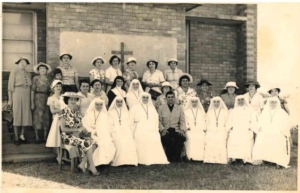
Two more wings, consisting of an extra fifty beds, were built in 1982. They were officially blessed by Bishop Wallace and opened by Senator Chaney on 3rd October that year. This opening coincided with the 800th anniversary of the birth of St Francis of Assisi. On Sunday 2nd December 1990 the new extension of fifty Hostel units was blessed by Rev D Carroll and opened by Hon P Staples. On 27th May 1997 the Home’s name was changed to “Francis of Assisi Home”. The old building was demolished and on 3rd November 2005, twenty-four high care rooms and a fifteen bed Memory Support Unit as well as a new kitchen were blessed by Bishop Brian Heenan, and officially opened by Mother Anselmina Mifsud, Superior General. In 2015 two sections of the home were demolished and rebuilt. The new building was blessed by Bishop Michael McCarthy and officially opened by Sr. Vittoriana DeBattista in October 2016.
The Home has continued to evolve since then with new upgraded systems and programs being implemented in 2022 and continuing till today. Underlying all our achievements is our Vision to which we strive daily:
“Serving with compassionate and generous love, those we care for.”
History of The Franciscan Sisters of the Heart of Jesus
The Congregation of the Franciscan Sisters of the Heart of Jesus was the first female Congregation founded in the Maltese Islands.
In 1877, a young girl from the Parish of St George Martyr at Victoria, Gozo, Maria Carmela Xerri, inspired by the book “The Bride of the Sacred Heart” written by the Italian priest, Fr Gaspare Olmi, and with the help of the Jesuit Father, Pietro Degiorgi a teacher at the Diocesan Seminary of Gozo, formed an Association “The Twelve Stars of the Sacred Heart”. The aim of the Association was to glorify the Sacred Heart of Jesus and to do reparation for the offences that the Sacred Heart receives from Mankind. The members were encouraged to value the virtues of humility, purity, and charity. Their aspiration was to strive hard to become saints through prayer, by living the sacraments, cultivating true devotion to the Blessed Sacrament and cherishing Marian devotion.
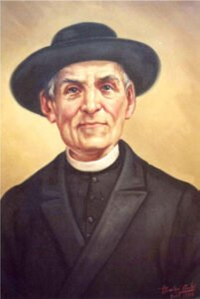
Since the group formed part of St George’s Martyr Parish, Victoria, Fr Joseph Diacono, a young priest, was given charge of the Group. He was a zealous priest and worked hard to promote their spirituality. Initially, they used to meet at the house of Ms Xerri but as the group was flourishing, the place was not adequate and started gathering in the Church of St Savina, in Victoria. They used to meet regularly every first Friday of the month. After some time, Fr Diacono rented a house at Għajn Qatet Street, Victoria, which he named as ‘The House of Charity’.
Fr Diacono not only insisted on the spiritual formation of the group but also led it to apostolic and social care of the poor young ladies of the Island. A young girl from Kercem, Gozo, Virginia De Brincat, who later became Mother Margherita of the Heart of Jesus, having finished her primary education, used to go frequently on foot from Kercem to Victoria for private lessons in Italian and French. During such time she used to pay a visit to Jesus in the Parish Church of St George, where she heard about this new association and immediately resolved to become a member, thus making her first authentic encounter with the Heart of Jesus. In fact, we know that she joined this association on the 8th of December 1877.
Through the work of Fr Joseph Diacono, in 1880, the Association evolved into a Religious Congregation with the name of “Franciscan Tertiaries”, which, in 1937 was changed to that of “Franciscan Sisters of Malta”. On the 15th of August 1880, eight young ladies who were members of the Third Order of St Francis started living together in the House of Charity. They were helped by a set of guidelines prepared by Fr Diacono, which continued to be renewed throughout the years. It was for this reason that Fr Diacono was known as the Founder.
On the 1st of September 1880, the group was approved by Bishop Peter Pace. A group of twelve young ladies started their formation for their First Profession. On the 18th of October 1880, they started their postulancy as Franciscan Tertiaries. Their dress was grey with a black rope and a white veil. When they went out, they put on a black veil. On the 15th of August 1881, they started their novitiate, while the First Profession was in August the following year. On 6th May 1886, after various insistence on the part of Diacono, Bishop Mgr. Pietro Pace officially consigned the Rule of the Third Order Regular of St Francis together with the Constitutions to the young community.
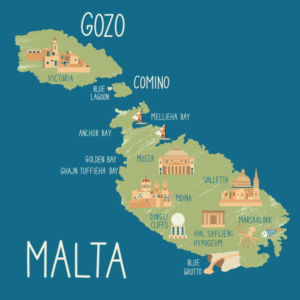
On 5th February 1881, Virginia left her father’s house at Kercem to start her religious formation and entered the House of Charity in Għajn Qatet Street, Victoria. On the 20th of February of the same year, she began her Novitiate as Mistress Virginia of the Blessed Margaret. This was her first official personal relationship with the Heart of Jesus, because like the Blessed Margaret Mary Alacoque who was canonised later, in May 1920, Virginia wanted to be an apostle of the Heart of Jesus.
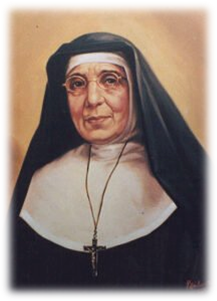
On 8th December 1887 Virginia did her second Religious Profession and became Sister Margherita of the Heart of Jesus. She was the first to walk at the head of so many Franciscan Sisters of the Heart of Jesus. It was probably on the 8th October 1887, Mother Margherita was called in a supernatural way to leave the House of Birkirkara where she was residing and go to Gozo. Father Joseph Diacono who, due to financial problems, was about to dissolve the Congregation and she humbly accepted the burden of the religious family.
The Beginning was hard and difficult: poverty, simplicity, joy, a fraternal spirit and total abandonment to the will of Him who is Love characterized the life of the Foundress and of her first Sisters. It was when Mother Margherita was General Superior, that the Congregation spread beyond the frontiers of the Maltese Archipelago: in 1907 the House of Corfù was opened to give spiritual assistance to the many Maltese who had emigrated there. In 1922 the first two houses were opened in Sicily, Italy. In 1927, Mother Margherita, as a member of the General Council supported enthusiastically the opening of the first house in Ethiopia.
Above all, Mother Margherita deserves credit for having given to the Congregation its valuable charism centered on LOVE, while she guided it for many years. Till the end, she continued to mould her Institute by her example and her teachings. It was this which helped the Congregation gradually to realize its true identity and charismatic maturity. Many houses were opened in all the continents, and according to the norms inspired by the Second Vatican Council, the present name of “Franciscan Sisters of the Heart of Jesus” was chosen. The Franciscan Sisters are presently in Malta/Gozo, United Kingdom, Italy, Jerusalem, Corfù, Australia, Brazil, Pakistan, Philippines, Ethiopia, Kenya and Mozambique.
Mother Luisa Busuttil, then Mother General of the Franciscan Sisters of Malta, agreed to a foundation at Mackay. Six Sisters arrived in Mackay in 1954 to start an aged care home, then called St Vincent de Paul. This name was officially changed in 1997 to Francis of Assisi Home.
Life of St Francis of Assisi
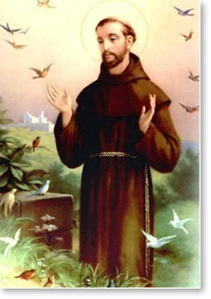 Francis of Assisi was born c. 1181 as Giovanni di Pietro di Bernardone, one of the children of an Italian father, Pietro di Bernardone dei Moriconi, a prosperous silk merchant, and a French mother, Pica di Bourlemont. Francis was an Italian Catholic friar who founded the religious order of the Franciscans. He is commonly portrayed wearing a brown habit with a rope tied around his waist, featuring three knots symbolizing the three Franciscan vows of poverty, chastity, and obedience.
Francis of Assisi was born c. 1181 as Giovanni di Pietro di Bernardone, one of the children of an Italian father, Pietro di Bernardone dei Moriconi, a prosperous silk merchant, and a French mother, Pica di Bourlemont. Francis was an Italian Catholic friar who founded the religious order of the Franciscans. He is commonly portrayed wearing a brown habit with a rope tied around his waist, featuring three knots symbolizing the three Franciscan vows of poverty, chastity, and obedience.
Indulged by his parents, Francis lived the high-spirited carefree life typical of a wealthy young man. He was handsome, witty, delighted in fine clothes and spent money lavishly. Although he had a love of pleasures, his displays of disillusionment toward the world that surrounded him came fairly early in his life. Around 1202, he joined a military expedition against Perugia and was taken as a prisoner. He spent a year as a captive, during which an illness caused him to re-evaluate his life. However, upon his return to Assisi in 1203, Francis returned to his carefree life. In 1205, Francis left to enlist in the army of Count of Brienne. A strange vision made him return to Assisi and lose interest in worldly life. Thereafter he began to avoid his former companions. He had a vision of Jesus Christ in the forsaken country chapel of San Damiano, just outside Assisi, in which the Icon of Christ Crucified said to him, “Francis, Francis, go and repair My church which, as you can see, is falling into ruins.”
In February 1208, Francis was inspired by the Gospel “Commissioning of the Twelve” from the Book of Matthew to devote himself to a life of poverty. Within a year Francis had eleven followers. The brothers lived a simple life in the deserted leper colony of Rivo Torto near Assisi. In 1209 he composed a simple rule for his followers (“friars”), the Regula primitiva or “Primitive Rule”, which was “to follow the teachings of our Lord Jesus Christ and to walk in his footsteps.” He then led eleven followers to Rome to seek permission from Pope Innocent III to found a new religious order. Though a number of the pope’s counsellors considered the mode of life proposed by Francis to be unsafe and impractical, following a dream in which he saw Francis holding up the Lateran Basilica, he decided to endorse Francis’s order. This occurred on 16 April 1210 and constituted the official founding of the Franciscan Order. Francis set out to replicate Christ and literally carry out his work. This is important in understanding Francis’ character, his affinity for the Eucharist and his respect for the priests who carried out the sacrament. He preached: “Your God is of your flesh, He lives in your nearest neighbour, in every man.”
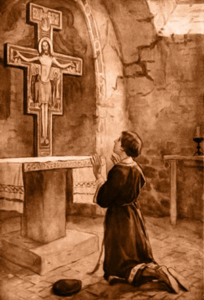
Hearing Francis preaching in the church of San Rufino in Assisi in 1211, the young noblewoman Clare of Assisi sought to live like them. Francis received her at the Porziuncola and thereby established the Order of Poor Clares. While he was praying on the mountain of Verna, during a forty-day fast in preparation for Michaelmas (29 September), Francis is said to have had a vision on or about 17 September 1224, the Feast of the Exaltation of the Cross, as a result of which he received the stigmata. Suffering from these stigmata and from trachoma, Francis received care in several cities to no avail. In the end, he was brought back to a hut next to the Porziuncola where he spent his last days dictating his spiritual testament. He died on the evening of Saturday, 3 October 1226, singing Psalm 141, “Voce mea ad Dominum”. On 16 July 1228, he was declared a saint by Pope Gregory IX. The next day, the pope laid the foundation stone for the Basilica of St. Francis in Assisi. Francis was buried on 25 May 1230, under the Lower Basilica.
He and his followers celebrated and even venerated poverty, which was so central to his character that in his last written work, the Testament, he said that absolute personal and corporate poverty was the essential lifestyle for the members of his order. He believed that nature itself was the mirror of God. He called all creatures his “brothers” and “sisters” and even preached to the birds. Francis preached the Christian doctrine that the world was created good and beautiful by God but suffers a need for redemption because of human sin. Francis’ feast day is observed on 4 October. A secondary feast in honour of the stigmata received by Francis, is celebrated on 17 September.
